Agile software development has revolutionized how teams approach complex projects. This approach helps teams adapt, collaborate, and deliver high-quality products quickly. But how do Agile frameworks achieve this?
The answer lies in the Agile manifesto, which emphasizes four core values:
- Individuals and interactions,
- working software,
- customer collaboration,
- and responding to change.
These values transform not only how teams approach work but also how they’re structured—emphasizing flexible roles, continuous feedback, and strong teamwork. Simply put, to make Agile work, you need the right people in the right roles.
So, what are the key roles in agile software development, and how do they fit into this dynamic framework? This article will break down critical agile software development roles, explore their responsibilities, and show how they work together to drive project success.
Agile software development roles in Scrum vs. Kanban
Scrum and Kanban are two of the most popular Agile methodologies. While both share the foundational Agile values, each has its own unique approach to organizing work and defining roles within the team.
Let’s examine the distinct characteristics of Kanban vs Scrum.
Scrum
Scrum teams work in fixed-length cycles called sprints, typically lasting 1– 4 weeks. Each sprint is dedicated to delivering predefined goals and deliverables.
The sprint starts with sprint planning, where the team agrees on what will be accomplished. Daily stand-ups ensure everyone is on track. At the end of each sprint, the team has a sprint review and retrospective.
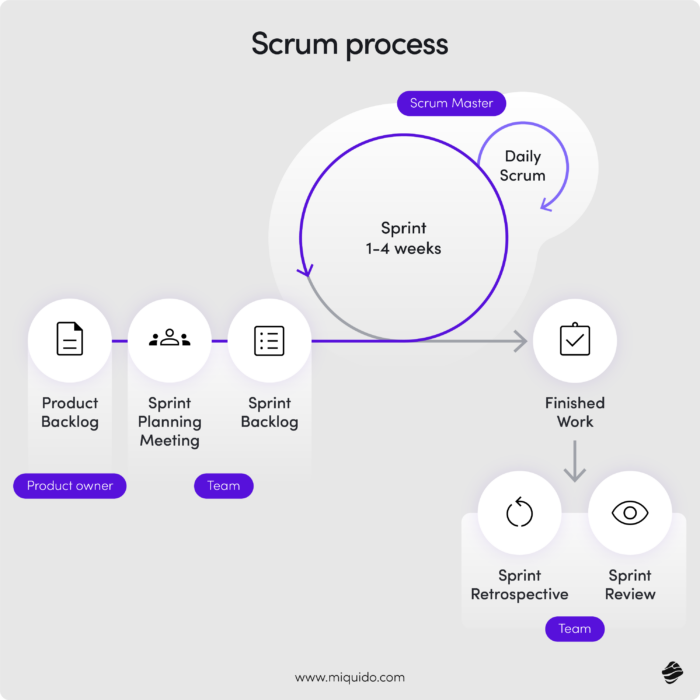
Scrum defines specific roles and responsibilities that are crucial for maintaining this structure:
- Product Owner: Represents the customer or stakeholders’ interests.
- Scrum Master: Acts as a facilitator for the team.
- Development team: Responsible for developing and delivering the product.
Scrum’s clear role definition and time-bound structure make it ideal for teams that benefit from clear expectations and regular feedback loops.
Kanban
Kanban, on the other hand, is a more flexible, flow-based methodology. It focuses on visualizing workflows using a Kanban board.
The tasks move through columns that represent different stages in the workflow, such as “To Do,” “In Progress,” and “Done.” You can customize these stages to match your unique workflow. Check out the below template’s example.
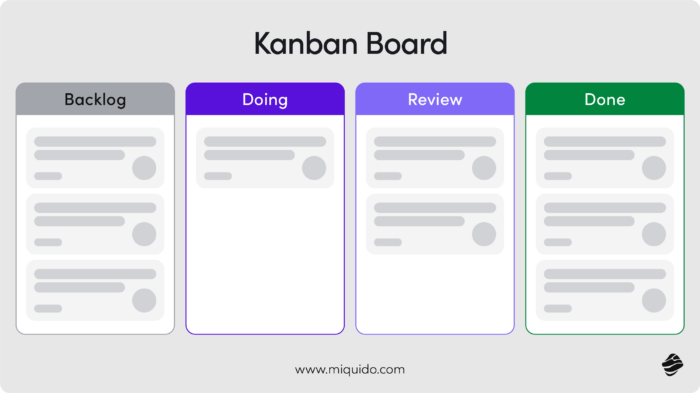
Unlike Scrum, Kanban doesn’t use sprints or fixed-length iterations. Work is pulled through the system based on the team’s capacity.
Kanban has no mandatory predefined roles since it emphasizes flexibility and self-organization. However, teams often adopt roles such as:
- Service Delivery Manager: Responsible for ensuring the smooth flow of work and managing the product delivery process. This role involves resolving bottlenecks, tracking progress on the board to improve time to delivery, facilitating Kanban cadences or meetings, and improving throughput.
- Service Request Manager: Oversees the intake of new service requests, ensuring the tasks are prioritized and added to the Kanban board efficiently.
Kanban is ideal for teams that need flexibility and continuous delivery without the constraints of fixed sprints.
Breakdown of key roles in agile software development
Agile software development relies on a well-coordinated team. Each Agile methodology might have slight variations in roles, but the key players tend to remain consistent across most Agile practices. Let’s dive into the specific roles in agile software development.
1. Product Owner
Product owners are critical in Agile software development, especially in the Scrum framework. They represent the customer’s perspective in the team and act as liaisons between the engineering and business teams.
Key responsibilities:
- Defining and prioritizing the product backlog: The Product Owner creates and continuously updates the product backlog, which is a prioritized list of tasks, features, and requirements for the development team.
- Communicating the product vision: They are responsible for communicating the product vision and goals to the development team. They ensure everyone understands what needs to be built and why it matters to the customer or business.
- Stakeholder management: The Product Owner is responsible for regularly updating external stakeholders on the project’s progress. They also gather feedback and adjust priorities as needed to ensure the team’s work aligns with the product strategy.
Of course, the strategy is the product manager’s turf, but product owners still need a great blueprint to work with. They can chip in to ensure they hand over a great product. Most software development companies actually offer product strategy services.
So, how does the Product Owner role interact with the other key roles on your Agile team?
The Product Owner works closely with the Scrum Master to ensure the agile development process runs smoothly. Additionally, the Product Owner interacts daily with the development team—clarifying requirements, providing feedback, and adjusting priorities when necessary.
2. Scrum Master
The Scrum Master is responsible for facilitating the Agile process and ensuring the team follows the Agile principles. They ultimately guide the Scrum team members to self-organize and be more efficient.
Key responsibilities:
- Facilitating Scrum events: The Scrum Master organizes and leads Scrum ceremonies such as daily stand-ups, sprint planning, sprint reviews, and retrospectives.
- Removing obstacles: They identify and remove any obstacles that could hinder the team’s progress. These could be anything from a lack of resources to team conflicts to other external dependencies like stakeholder interruptions.
By effectively fulfilling their key job roles, Scrum Masters foster a collaborative culture. They promote open communication and encourage a positive team dynamic that ensures smooth interactions between development team members and stakeholders.
3. Development team
The Agile development team is a cross-functional group responsible for delivering high-quality products. This team typically includes specialists such as software developers, quality assurance (QA) testers, UI/UX designers, and DevOps engineers.
Key responsibilities:
- Delivering increments of working software: The Agile development team works on developing, testing, and delivering functional software at the end of each iteration.
- Continuous learning: The team is committed to continuous learning and improvement. They participate in reviews, retrospectives, and other Agile ceremonies to review their work.
Additionally, they take the initiative to learn new skills, tools, or techniques that enhance their ability to deliver high-quality products.
Keep in mind Agile development teams are built to be self-organizing. This means they manage their own work and collaborate closely to achieve sprint goals.
4. Supporting roles in Agile
In addition to the core roles, an Agile development team can include several supporting roles that enhance the process’s efficiency and success.
These roles may not always be present in every Agile team, but when they are, they provide specialized expertise that guides the project toward long-term success.
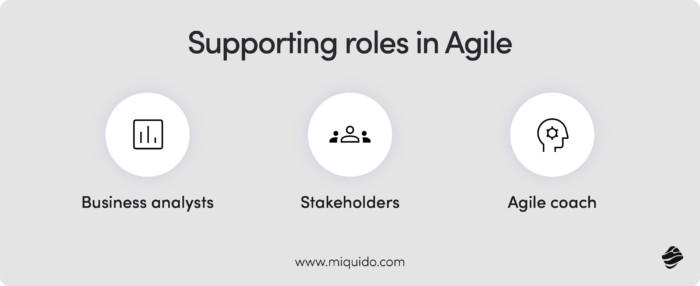
Business analysts
Business analysts (BAs) translate the client business’s needs into technical requirements. They provide valuable support, especially in situations where the complexity of the requirements demands deep analysis.
Key responsibilities:
- Translating business needs: BAs translate complex business problems into technical requirements or user stories that are more understandable for the development team.
- Ensuring alignment: Business Analysts ensure the team is always working on the features that deliver the highest business value, often working hand-in-hand with the Product Owner.
- Data analysis: They also provide insights into customer or system data, which can help prioritize features based on user behavior or business needs. For instance, if you are building a mobile app, they can provide in-depth details about key mobile app development trends.
Stakeholders
Stakeholders represent anyone with an interest in the product. There are two key types of stakeholders:
- Internal stakeholders: These are the people working for the company developing the product, such as employees, managers, etc.
- External stakeholders: External stakeholders, on the other hand, don’t work for the company. They include clients, end-users, suppliers, and investors.
Key responsibilities:
- Feedback loops: They often provide feedback during key Agile ceremonies like Sprint Reviews. Their input helps build a product that delivers the desired value.
- Decision-making: In collaboration with the Product Owner, stakeholders help make decisions on which features should be prioritized or delayed based on business needs.
Agile coach
An Agile coach helps teams and organizations adopt and improve Agile practices. They focus on guiding the team through the Agile transformation process, making sure that Agile principles are fully integrated into the company culture.
Key responsibilities:
- Running Agile training and mentorship: Agile Coaches educate teams and organizations on Agile practices and principles, ensuring all members understand and can apply Agile techniques. For instance, they can organize product workshops for development teams to help them understand the Agile approach.
- Improving processes: Agile Coaches, along with the Scrum Master and other leaders, help teams identify areas where their Agile processes can be optimized to deliver better results.
The supporting roles in Agile software development ensure teams have the insights, guidance, and technical support required to navigate any complexities of the Agile framework.
5. Agile leadership
In Agile, leadership is more adaptive and supportive than in traditional management approaches. Leaders focus on empowering teams, removing obstacles, and fostering an environment of continuous learning and improvement.
Some of the key leadership roles in Agile include:
- Chief Technology Officer (CTO): The CTO oversees the technological direction of the company and ensures that technology strategies align with business goals. They typically encourage experimentation and oversee the adoption of new technologies.
- Tech leads or engineering managers: This category provides technical leadership within Agile teams. Their role is to guide developers in making architectural decisions, ensuring code quality, and helping the team solve complex technical challenges.
- Business executives: Other C-suite executives, such as CEOs and COOs, are crucial in supporting Agile transformations by providing the resources and support necessary for teams to succeed. They also foster a culture of innovation and flexibility in the organization.
However, remember that rather than just directing the work, Agile teams’ leaders act as enablers. They provide mentorship and strategic direction while allowing the team to self-organize.
The importance of cross-functional teams
One of the cornerstones of agile software development roles is the cross-functional nature of teams.
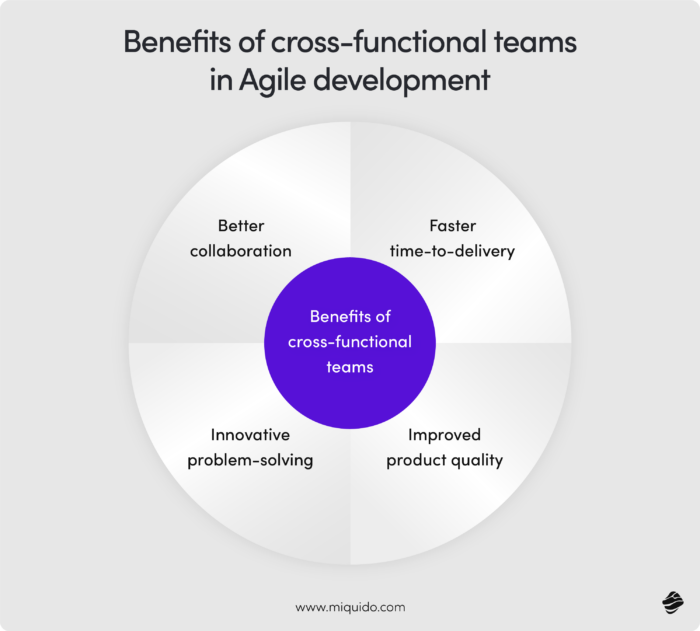
Here’s why these teams are so valuable in Agile development:
- Better collaboration: Having people from different disciplines—developers, testers, designers, and analysts—all on the same team enhances collaboration. Since everyone works together, there are fewer misunderstandings and more shared goals.
- Faster time-to-delivery: When all the expertise needed for a project is within one team, there’s no waiting for handoffs or approvals from other departments. This means faster decision-making and quicker progress.
- Improved product quality: With testers and quality assurance (QA) involved from the start, issues are spotted early. Continuous testing also helps ensure that each part of the product is well-tested before moving forward.
- Innovative problem-solving: Bringing together different perspectives (like a designer’s and a developer’s) sparks creativity. It leads to innovative solutions that might not have been thought of in a more siloed team setup.
Ultimately, cross-functional teams can handle all aspects of software development from start to finish without heavy reliance on external parties or departments.
Communication and collaboration in Agile
Agile methodologies emphasize continuous communication to ensure everyone stays aligned with the project’s goals and progress. This is achieved through meetings or “ceremonies” like daily stand-ups, sprint reviews, and retrospectives.
- Daily stand-ups: These 15-minute team-focused meetings are held every day. Each team member shares what they worked on, what they plan to do next, and any blockers they’re facing. This keeps everyone in the loop and helps address issues as they arise.
- Sprint reviews: At the end of each sprint, the team holds a sprint review to showcase the work completed during the sprint. This allows stakeholders to provide feedback, which can then be factored into future development cycles.
- Retrospectives: These meetings are about reflection. After a sprint, the team gathers to discuss what went well, what didn’t, and how they can improve moving forward. It’s a crucial part of Agile’s continuous improvement focus.
42% of leaders shared that efficient communication led to stronger teamwork and collaboration in their organizations. Collaboration tools such as Jira, Trello, and Slack can help streamline the process further.
These project management tools make it easy to share updates, manage tasks, and keep discussions organized, even for remote or large teams.
Evolution and flexibility of agile software development roles
Remember, while there are key roles like Product Owner or Scrum Master, Agile team members aren’t locked into rigid roles throughout. As teams mature and projects evolve, roles can shift.
For instance, an experienced Agile team will rely less on a Scrum Master for daily facilitation once they’ve developed stronger self-management skills. As a result, the leaders will shift into more of a mentorship role.
Additionally, a UI/UX designer will take on a more central role during a particularly design-heavy sprint. When the team is focusing on the product infrastructure and deployment tasks, a DevOps engineer will take the lead.
Common challenges in Agile roles
While the Agile framework is your best chance for better collaboration, a flexible workplace, and high-value products, it’s not without a few challenges. They include:
- Potential conflicts between roles: Different roles often have overlapping responsibilities, which can lead to confusion or conflict. For example, the Scrum Master and Product Owner may overlap in decision-making, leading to team inefficiencies or poor outputs.
Prevent this issue by clearly defining each role and its responsibilities at the start of the project. Additionally, the roles should be reviewed during retrospectives to resolve any overlap.
- Handling team dynamics: Agile teams are often cross-functional. The diverse backgrounds and skill sets can lead to differing communication styles and working methods. If not managed well, these differences can result in misunderstandings or tension within the team.
To resolve this, foster an inclusive environment where everyone feels valued and heard.
Not everyone on the team may fully understand or embrace Agile principles. For example, if a team member is more accustomed to traditional project management approaches, they might resist Agile practices like iterative development and embracing change.
To avoid this, provide continuous training and coaching to bridge this gap and help people get more comfortable with Agile practices.
Agile metrics and role accountability
Measuring success is crucial for ensuring that Agile teams are on track and continuously improving. So, how do you measure success in Agile? Here are some key metrics:
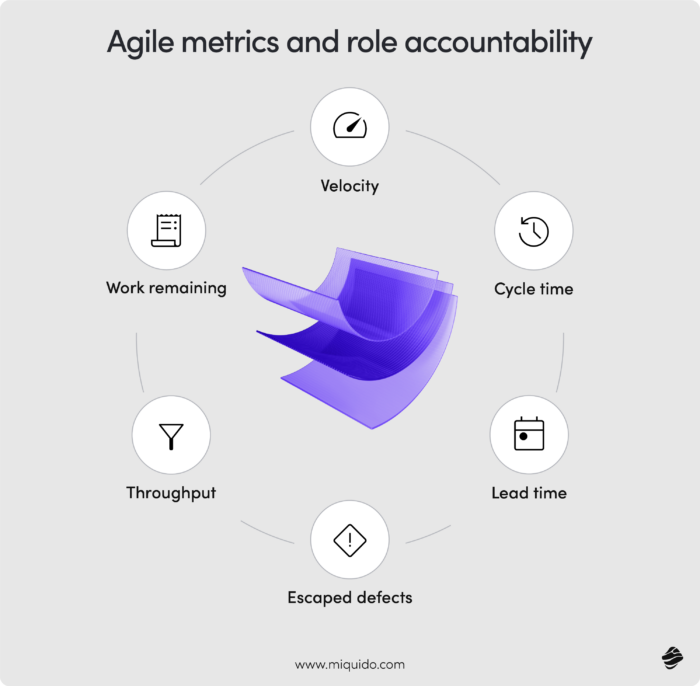
- Velocity: The amount of work a team can complete in a sprint, usually measured in story points. This will help you understand team capacity, making it easier to forecast future sprints.
- Cycle time: Cycle time measures the time it takes for a task to move from the start of development to completion. It assesses the efficiency of the team’s workflow, identifying bottlenecks or delays in the process.
- Lead time: Lead time is the total time taken from the moment a task is added to the backlog until it is completed and delivered. It provides insights into the efficiency of the entire software development process.
- Escaped defects: The number of defects found by end-users after the product has been delivered. This metric provides insight into the quality of the product while identifying areas for improvement.
- Throughput: The number of work items completed in a given period. It measures productivity and helps in capacity planning.
- Work remaining: Burndown charts help you track the amount of work remaining against the time left in the sprint or project. They help teams visualize progress and determine whether they’re on track to complete all tasks as planned. Here’s an example.
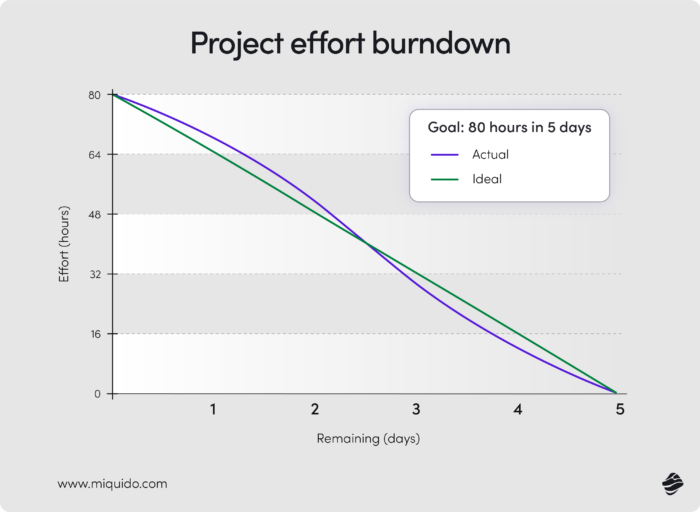
Scrum Masters, Product Owners, and Service Delivery Managers track these metrics with support from the development team. For instance, while measuring escaped defects, you must liaise with Quality Assurance (QA) professionals within the development team.
In closing
Agile software development relies on a well-defined set of agile team roles and responsibilities that allow team members to collaborate, adapt, and deliver value efficiently.
Everyone, from the Product Owner to the development team, leadership roles and supporting roles, plays a crucial part in ensuring that Agile principles are upheld.
Understanding and embracing the various roles in agile software development roles will help your team work more efficiently, easily adapt to changes, and continuously deliver value.
Don’t forget to consistently measure your success and make improvements to keep producing great outputs.









